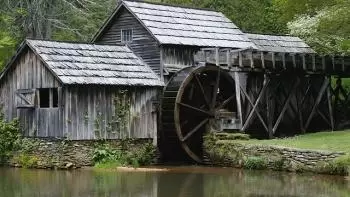
Hydraulic energy has always been a key resource for the development of humanity. For twenty centuries, humans have known how to take advantage of waterfalls to carry out mechanical work.
Today, the power of water is mainly used in hydroelectric power plants as a renewable energy source to generate electricity. There are different types of hydraulic power plants that generate electricity, such as flowing water power plants or reservoir power plants.
However, we are going to see how this technology developed throughout history.
The history of water power remote to the 4th century BC with water wheels and water mills dating back to the 4th century BC. Specifically in the Persian Empire before 350 BC, in the regions of Iraq, Iran, and Egypt.
The water wheel of the Roman Empire
In the Roman Empire, the energy of water began to be harnessed through mills. These water-powered mills were described by Vitruvius in the 1st century BC.
The Greeks and Romans initially used this type of renewable energy only to run simple water mills to grind corn. Roman water wheels were also used to saw marble.
Emergence of hydropower in China
In China, their water-powered hammers and bellows were theorized to date back to the Han Dynasty (202 BC - 220 AD). These mechanisms were powered by water scoops, but later historians believed they were powered by water wheels.
Islamic Golden Age
In the Muslim world during the Islamic Golden Age and the Arab Agricultural Revolution (8th-13th centuries), engineers made extensive use of hydroelectric power, as well as early uses of tidal power, and large factory complexes. hydraulics.
Industrial impulse at the end of the Middle Ages
At the end of the Middle Ages, with the discoveries brought by the Arabs from North Africa, other methods were used to exploit hydraulic energy. The waterwheel was increasingly used, both for the irrigation of fields and for the reclamation of vast swampy areas.
At the start of the industrial revolution in Britain, water was the main source of energy for new inventions. Although the use of water power gave way to the steam engine in the larger mills and factories.
Emergence of the hydraulic turbine
A technical progress of enormous proportions occurred at the end of the 19th century. Around the beginning of the Second Industrial Revolution, the waterwheel evolved into the water turbine.
The hydraulic turbine is a machine built by a pivoting wheel on an axis. At first it was a rough and schematic axis. The turbine improved the efficiency of converting the potential energy of water into rotational kinetic energy applied to a shaft.
In 1848, James B. Francis improved on these designs to create a 90% efficient turbine. Francis Turbine. Subsequently, in the first half of the 20th century, it became increasingly sophisticated and functional.
The Francis reaction turbine is still in wide use today.
Power generation
The advantage of hydraulic turbines is that they allow the rotational energy of the shaft to be transferred to an electrical generator to generate electricity.
The first hydroelectric power station was developed by the Niagara Hydroelectric Company, which used the falling water of Niagara Falls to generate electricity.